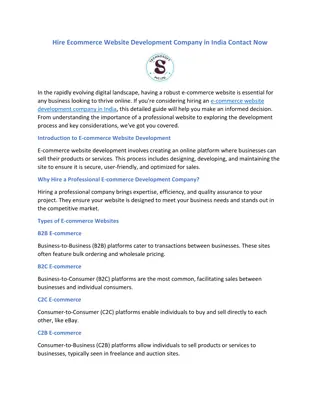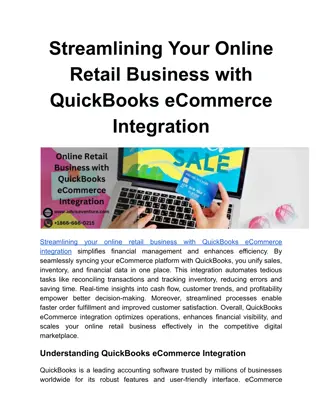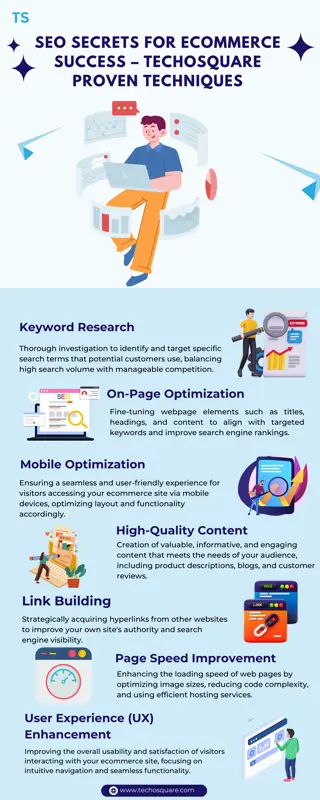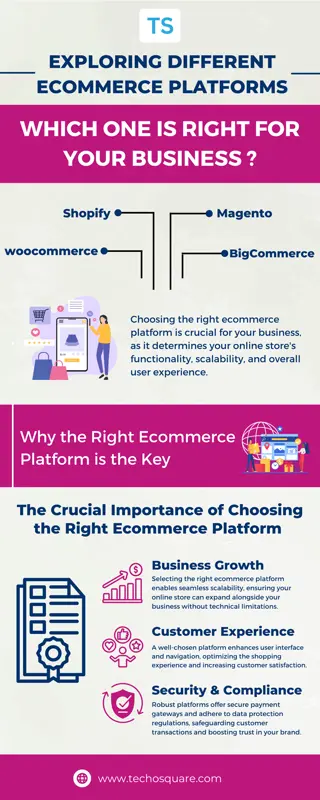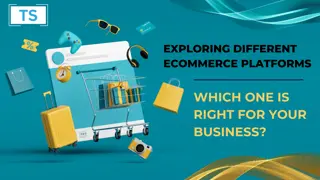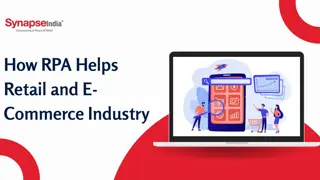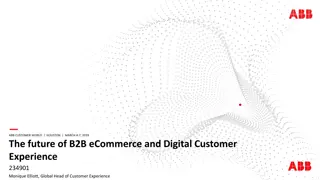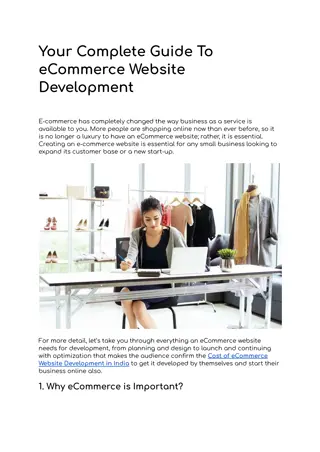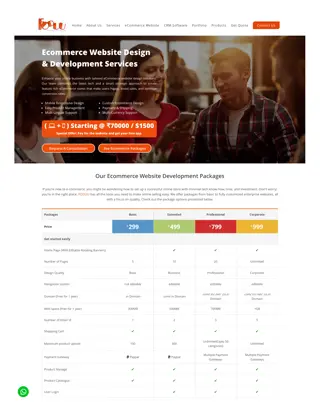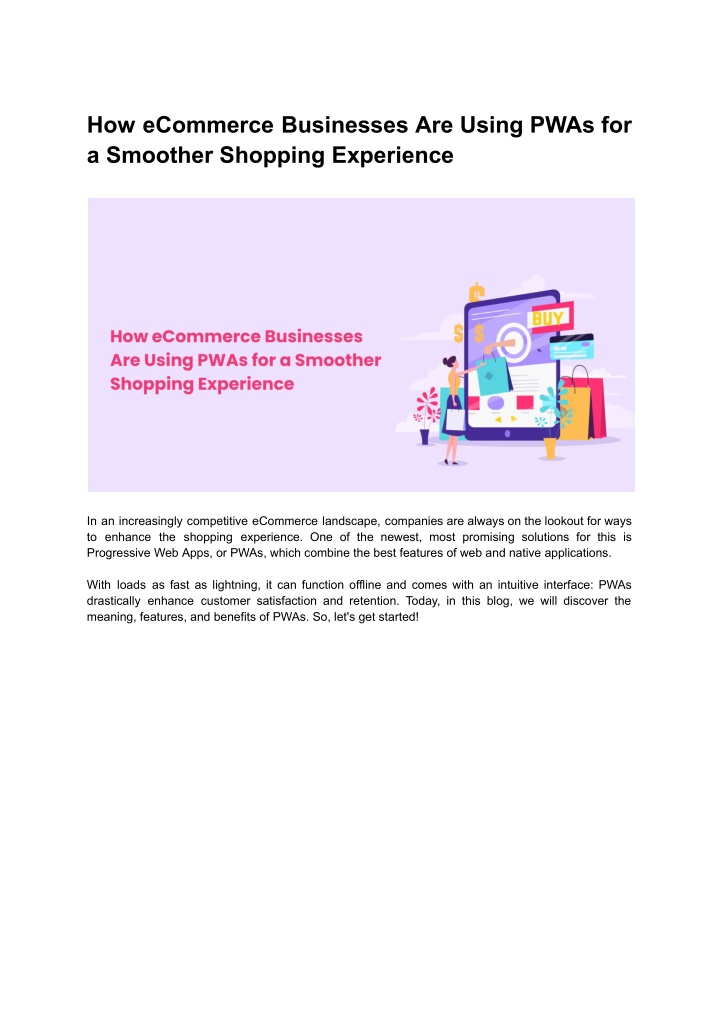
How eCommerce Businesses Are Using PWAs for a Smoother Shopping Experience
Progressive Web Apps (PWAs) are revolutionizing the eCommerce landscape by delivering faster, more reliable, and engaging shopping experiences. In this PDF, discover how leading eCommerce businesses are leveraging PWAs to provide seamless performance
Download Presentation

Please find below an Image/Link to download the presentation.
The content on the website is provided AS IS for your information and personal use only. It may not be sold, licensed, or shared on other websites without obtaining consent from the author. If you encounter any issues during the download, it is possible that the publisher has removed the file from their server.
You are allowed to download the files provided on this website for personal or commercial use, subject to the condition that they are used lawfully. All files are the property of their respective owners.
The content on the website is provided AS IS for your information and personal use only. It may not be sold, licensed, or shared on other websites without obtaining consent from the author.
E N D
Presentation Transcript
How eCommerce Businesses Are Using PWAs for a Smoother Shopping Experience In an increasingly competitive eCommerce landscape, companies are always on the lookout for ways to enhance the shopping experience. One of the newest, most promising solutions for this is Progressive Web Apps, or PWAs, which combine the best features of web and native applications. With loads as fast as lightning, it can function offline and comes with an intuitive interface: PWAs drastically enhance customer satisfaction and retention. Today, in this blog, we will discover the meaning, features, and benefits of PWAs. So, let's get started!
What is a PWA? Source A Progressive Web App is actually a web application that feels like a native mobile app. In other words, PWAs use web technologies such as JavaScript, HTML, and CSS to offer an engaging experience. Developers can use the Gatsby or VuePress tool to build PWAs connected to e-commerce platforms. PWAs run on a web browser but the result, if such a PWA is installed by users, is going to show up as an app on the mobile home screen, and it will offer an offline browsing experience. Core Features of PWA Changing the Online Shopping Experience If you hire a reliable PWA development company, you will get an app with amazing features. Here's an elaboration of these core features: 1. Native-like Design PWAs pop up with smooth and intuitive design, close to that of a native app. This makes navigation easy and enjoyable. More time will be spent on it and return visits will happen regularly, just because it feels right and rather easy. 2. Website Loading Has No Crash Time PWAs actually rely on caching techniques: they download parts of the website onto your device, allowing pages to load nearly instantaneously, even on a really slow internet connection. This helps cut down frustration and keeps the customer engaged because it loads much faster. 3. Offline Functionality This is one other exciting feature of PWAs which supports working without internet access. Users can browse through the products and add them to the cart. They are even allowed to start payment but all such changes get restored once it gets back online and works properly.
4. Add to Home Screen With just one tap, users will be able to add an icon of a PWA directly to their home screen as they would with any other installed application, bringing to them the ease of accessing the store they may be fond of. 5. Push Notifications PWAs enable the reception of messages at times even when the user is not using the application. To the business, this means they can remind customers of specific deals that may be ongoing, welcome customers to newly launched products, or notify a customer who, while using their cart and leaving the application, has items left in the cart. This is a great way of keeping them engaged. 6. Responsive Design PWAs are optimized for use with any device, that is, on the smartphone, tablet, or desktop. This means that regardless of the device by which a customer will access your site, she will enjoy a consistent, optimized experience short, shopping becomes easy. 7. App-like Gestures PWAs support familiar actions like swiping, tapping, and smooth scrolling. It will make a shopper feel more comfortable and enjoyable as a native app while he's shopping. PWAs use HTTPS, which ensures all communications between the user and the site are encrypted. This results in greater customer trust, ensuring their personal and payment information is safe. 8. Easy Updates Background updates allow PWA to update automatically. The outcome is that users are sure to get access to the latest features or products without having to download anything. This makes the shopping experience fresh and up-to-date. 9. Cross-platform Compatibility Once a shopper starts shopping on one device, they can pick up where they left off on the other. For instance, shoppers can browse on a mobile and then finalize their purchase on a laptop, ensuring all experience flows through devices. 10. Streamlined Checkout PWAs can save customer information and payment information securely. This means fast, one-click purchases that minimize cart abandonment. Customers love checking out quickly, saving them time. 11. Better Product Discovery PWAs can also make use of functionalities, like the camera in the device, to employ visual searches or augmented reality. This way, customers will be able to scan a picture or see how the product will look in real life in their home. All this increases the capability of the customer when it comes to making a purchasing decision. 12. Personalization Through PWAs, the interests of users can be remembered and past behavior learned. The customer will receive recommendations as well as content relevant to their interests, thus creating relevance and making the shopping experience engaging.
13. Connecting with Social Media The PWA can easily connect to the social media environment. In this regard, the users can share their likes for products, wishlists, or even purchases with friends, thereby making online shopping, along with a social factor, and in theory, attracting more people into the store. Advantages of Progressive Web Apps PWAs can capitalize on increasing mobile shopping. 1. Reach to Larger Audiences PWAs can be reached from any device that has a web browser. It's easy to share through a link, thus reaching more users compared to the download-based model of traditional apps. 2. Lower Development Costs Developing different native applications for every variant platform (like iOS and Android) can be expensive and time-consuming. PWAs work from a single codebase to serve all users, thus cutting development and maintenance costs. 3. Speed and Accessibility Fast load times are one of the major reasons for retaining users. PWAs give an experience that is fast even with poor network conditions. This leads to a better retention and satisfaction level. 4. Increased Conversion Rates Due to the fact that PWAs offer enhanced user experience, it may lead to more sales. For example, Alibaba saw large-scale conversions after implementing PWAs, which makes it a proven solution. The Technologies Behind PWAs PWAs apps work on modern technologies. This is why you need a trusted firm with expertise in providing custom software development services, who knows the technology inside out. Here are some core technologies behind PWAs: Service Workers: This is a backend script that will add functionality for an off-line application and push notifications which improves user experience Web App Manifest: This is a JSON file, it provides information regarding the PWA such as name, and icon, so it shows up right on the devices. HTTPS: A secure connection offers safety for users' data and prevents its tampering. This approach basically loads minimalistic HTML, CSS, and JavaScript quickly to give a faster, native-like feel. Responsive Design: PWAs employ flexible layouts that adapt to different screen sizes for a consistent user experience. Final Thoughts That s all about PWAs. PWA is revolutionizing the eCommerce environment by making the experience faster, allowing access while not connected to the internet, and offering an application-like feel.
Businesses who want to create such apps can hire a leading partner with proficiency in providing eCommerce software development services. Remember, creating an app is not enough. It should be efficient, feature-rich, and updated. Source URL: https://usawire.com/how-ecommerce-businesses-are-using-pwas-for-a-smoother-shopping-experienc e/







